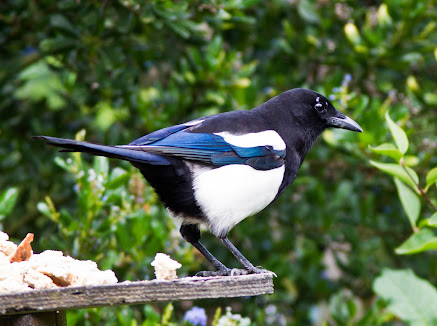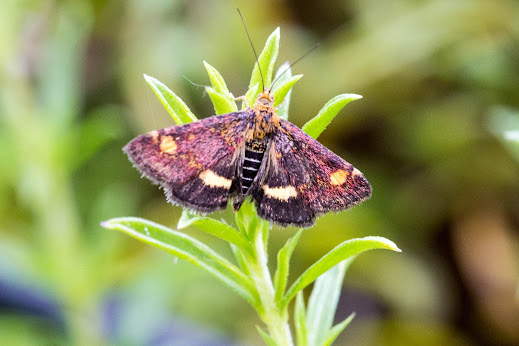A to Z challenge 2023 – M is for . . .
My
theme for this challenge is Nature in all much of her wonderful
diversity. My posts will reflect the fact that I am resident in the south of
England.
All
photographs in this post are the property of the writer.
Magpie (Pica pica)
Although it may be described as a black and white bird, the magpie displays other glossy iridescent colours of purple, green and blue on its wings and tail.
The long tail amounts to half the entire length of the bird, except for young magpies, which have short tails. Juveniles also look rather washed-out, with their white parts looking quite grubby.
Juvenile.
For some reason Rudyard Kipling's poem came to mind, or, rather, the refrain:
'Boots-boots-boots-boots-movin’ up and down again!'
There are several collective nouns for magpies – conventicle, gulp, mischief, tidings or tribe. I like the alliteration of ‘mischief of magpies’.
A mischief of magpies will frequently gather in spring to decide territorial rights and social hierarchy. This is important because magpies do not stray far from the areas in which they hatch.
There are those boots again!Magpies often pair for life, and when preparing to breed, male and female build a large, untidy nest from branches and twigs and line it with mud and leafy material. Both parents feed the young.
I suggest that most of us know the nursery rhyme about magpies, which counts to seven, but the longest rhyme is local to Lancashire.
One
for sorrow, two for joy,
Three
for a girl, four for a boy,
Five
for silver, six for gold,
Seven
for a secret never to be told.
Eight
for a wish, nine for a kiss,
Ten
a surprise you should be careful not to miss,
Eleven
for health, twelve for wealth,
Thirteen
beware, it’s the devil himself.
Mint moth (Pyrausta aurata)
The caterpillars of this tiny pretty moth feed on herbs like mint, thyme and marjoram and this is where adults are likely to be found resting during the day when they are not flying. The moths also fly at night.
The mint moth is sometimes called the small purple and gold and can be seen on the wing from April to September, and occasionally a month either side.
It occurs patchily across England, Wales, southern Scotland and the Inner Hebrides. Sunny summer days are the best times to try and spot them.
Moss
I know very little about moss, but a closer look reveals a miniature world of wonder.












Moss is quite fascinating.
ReplyDeleteYour magpies are very different to ours. Ours are only black and white, with some not quite black and not quite white thrown in.
Australian magpies are not related to corvids. I love the song of your magpies.
DeleteI never heard that poem before. I've only seen magpies when I was in Norway almost 40 years ago.
ReplyDeleteThey are very common in UK.
DeleteHi Janice - I'll be around to run through your other A- Ms so far! I'm afraid I call our magpies thugs ... but nature is life. They have beautiful colours. Thanks for the reminder re 'Boots, boots ... ' poem. Your mint moth is beautiful ... and I love moss - cheers Hilary
ReplyDeleteThank you, Hilary. I think I might study moss a little more closely, when I've got time.
ReplyDeleteMagpies pair for life, built the nest together and share the childcare? I am well impressed.
ReplyDeleteHumans could learn a lot from birds!
DeleteI had no idea juvenile magpies had short tails!
ReplyDeleteLoving collective nouns, and mischief of magpies is my preference too. Fascinating facts on both magpies and moths, and I don't know much about moss either :-) xxx
It sounds as though you're a collector of words, too :-) x
DeleteLove the magpie photos -- that blue is gorgeous. Nice to learn that magpies set an egalitarian example by sharing care of their young!
ReplyDeleteYes, none of that 'I expect my tea on the table when I get home' - an attitude still sadly in evidence in some parts of the country.
DeleteI did not know our magpies are not corvids. I thought they were, so I rushed to find my bird book and discovered I was wrong.
ReplyDeleteWe never stop learning . . .
ReplyDeleteMy little great grandson saw a crow with a purplish blue head and he laughed and laughed,. Interesting post.
ReplyDeleteYou never cam tell just what will tickle a child's funny bone.
ReplyDeletethanks for your ID on my moth. I live in south Manchester and magpies are definitely the dominant bird species, even out doing the pigeons I think:-)
ReplyDeleteOutnumbering pigeons takes some doing.
ReplyDeleteI’ve always heard about magpies, but don’t think I’ve ever seen one. They are an interesting bird - good pictures. Thanks for your focus on nature. It’s one of my favorite subjects too. www.shirleyjdietz.com. from A to Z
ReplyDeleteThank you for visiting.
DeleteThey're common here, but always interesting to watch,
DeleteWe often get Magpies in the garden but not many butterflies - we have a very low maintenance garden with very few plants although the lavender we do have does attract the bees. Thanks for your visit to my blog.
ReplyDeleteBees are important for life, so it's good they visit your lavender.
ReplyDeleteI like a "mischief of magpies" too.
ReplyDeleteRonel visiting for M:
My Languishing TBR: M
Mystifying Muse
It's an appropriate noun for such entertaining birds.
ReplyDelete